Behind every ventilator is a respiratory therapist
- Category: Health & Wellness
- Posted On:
- Written By: Deb Sutton, Sweetwater Memorial Public Information Officer

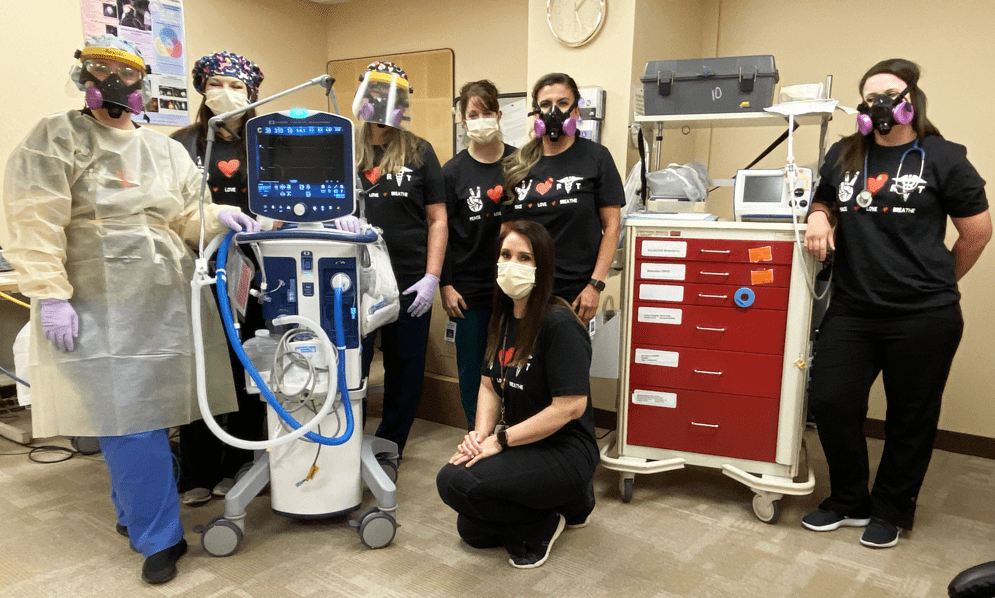 MHSC Registered Respiratory Therapist Amanda Armendarez, from left, performs an arterial blood gas draw, while RRT Carol Burke sets up the ventilator for a mock patient (Certified Respiratory Therapist Danielle Ollis). RRT Amanda Rockwood, manages the patient’s airway, in effect, helping the patient to breathe. –Memorial Hospital of Sweetwater County photos
MHSC Registered Respiratory Therapist Amanda Armendarez, from left, performs an arterial blood gas draw, while RRT Carol Burke sets up the ventilator for a mock patient (Certified Respiratory Therapist Danielle Ollis). RRT Amanda Rockwood, manages the patient’s airway, in effect, helping the patient to breathe. –Memorial Hospital of Sweetwater County photos
COVID-19 virus has created
unprecedented challenges for the profession
There are about 150,000 respiratory therapists in the United States, according to the American Association of Respiratory Care.
If they’re anything like those who are part of the 11-person team at Memorial Hospital of Sweetwater County, they are well-trained. They have to be; COVID-19 is primarily a respiratory-related illness that impacts a person’s ability to breathe.
Respiratory therapists nationwide are in the thick of the outbreak, managing ventilators and assisting with intubations, said Crystal Hamblin, MHSC Cardiopulmonary Services Director.
The respiratory team trained for these special circumstances for nearly two months. They are an important part of the patient’s healthcare and are ready to go.
“They’re the ones who will help clear your airways, give you a breathing treatment and make sure you have enough oxygen to breathe,” Hamblin said.
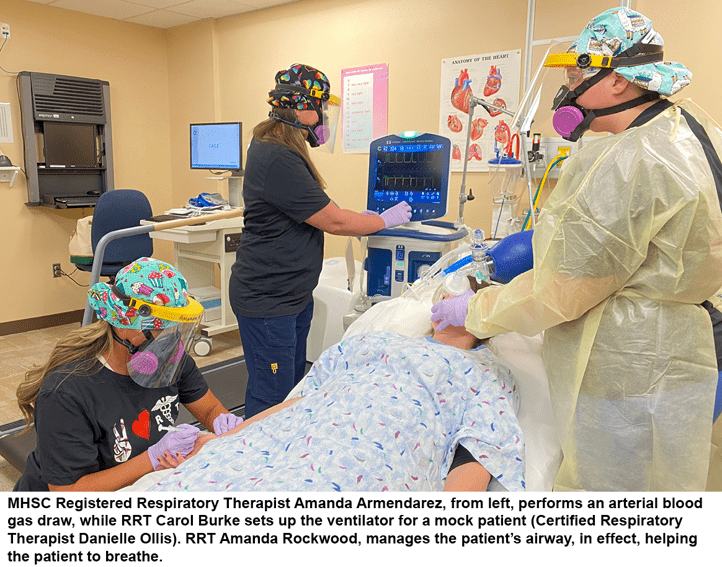
Respiratory therapists also are the ones who will be there when it’s time to take the patient off of a ventilator – whether the outcome is good or bad.
Hamblin, who has spent 19 years as a nurse and respiratory therapist, said the virus has created unprecedented challenges for her profession.
“The majority of the procedures that therapists perform are at the head of the bed, putting therapists at a high risk for infection,” she said. “Everything we do aerosolizes the virus and we have had to rethink how to help the patients breathe in a much safer way. Protecting patients and staff has been my No. 1 concern.”
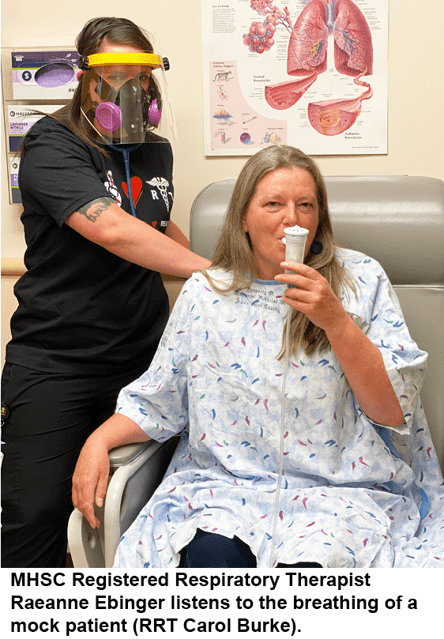 “Respiratory therapists are the people managing the ventilators,” Hamblin said. “We are the only healthcare clinicians didactically and clinically educated and trained in the art and science of mechanical ventilation.
“Respiratory therapists are the people managing the ventilators,” Hamblin said. “We are the only healthcare clinicians didactically and clinically educated and trained in the art and science of mechanical ventilation.
“Ventilators are what makes a respiratory therapist a respiratory therapist,” she explained. “That’s what sets us apart from all other disciplines of medicine – the knowledge of ventilators. Nobody else in medicine is trained on ventilators as deeply and thoroughly as we are.”
Registered Respiratory Therapist Amanda Armendarez agreed.
She said a respiratory therapist’s knowledge of the cardiopulmonary system makes them especially important in the midst of the coronavirus pandemic. Their advanced knowledge of mechanical ventilation makes them even more important.
“It’s up to the respiratory therapist to determine the appropriate settings on the ventilator to effectively keep a person breathing and oxygenated while their body fights the virus, RRT Carol Burke said.
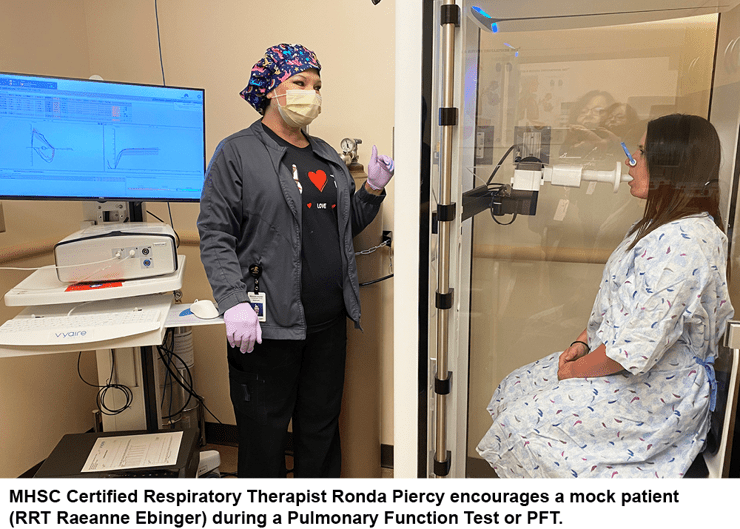 “We make sure that the patients have an open airway and respond to critical situations, such as cardiac or respiratory arrest,” RRT Raeanne Ebinger added. “We have to know everything about the patient, and their diseases to properly treat them”
“We make sure that the patients have an open airway and respond to critical situations, such as cardiac or respiratory arrest,” RRT Raeanne Ebinger added. “We have to know everything about the patient, and their diseases to properly treat them”
“We also perform the ‘aerosol generating procedures’ like breathing treatments and non-invasive ventilation,” Certified Respiratory Therapist Ronda Piercy said. “We are right there at the head of the bed assisting with intubations, extubations, mechanical ventilation, and cardiopulmonary resuscitation.”
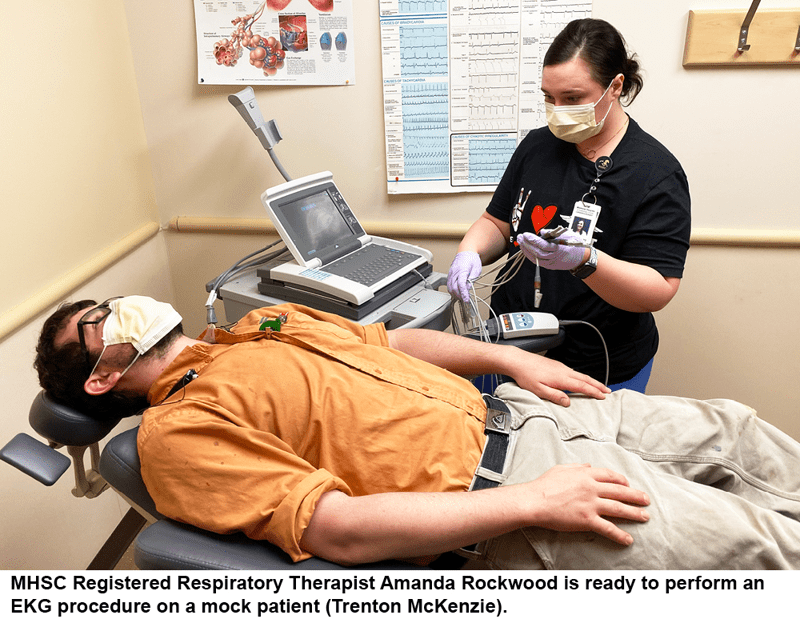 Their jobs can be challenging and a little scary, said RRT Amanda Rockwood.
Their jobs can be challenging and a little scary, said RRT Amanda Rockwood.
“We are right there,” Rockwood said. “We’re so close. So, it does make it much more challenging and scarier because of so much uncertainty with this disease. There is some anxiety of not knowing if the patients presenting in respiratory distress – those who are getting breathing treatments or an EKG for chest pain – have COVID-19.”
There is a vast amount of training that prepares them to be skilled professionals. Respiratory Therapy is a credentialed, licensed healthcare field specializing in care for the cardiovascular and pulmonary systems. With that, therapists collaborate closely with physicians and nurses.
Increased demand for therapists during the pandemic has highlighted a shortage that has persisted for years, according to Lori Tinker, the chief executive officer of the National Board for Respiratory Care. The respiratory therapist shortage exists in part due to a low awareness of the profession, Tinker said.
“The shortage has been growing, and I think it’s going to be an even bigger shortage after this is over,” Tinker said in a recent interview. “In addition, therapists are not considered healthcare providers under federal government, but rather hospital or laboratory personnel.”
Hamblin is proud of her team and profession.
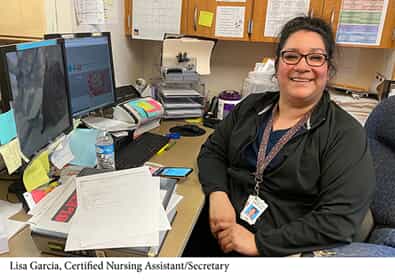 “I appreciate their patience, professionalism, hard work, sacrifice and commitment to providing excellent care during this pandemic,” Hamblin said. “Many of them have sacrificed time with loved ones, self-care and their own safety to provide care to those infected. It’s because of them so many patients affected by the virus have already recovered.”
“I appreciate their patience, professionalism, hard work, sacrifice and commitment to providing excellent care during this pandemic,” Hamblin said. “Many of them have sacrificed time with loved ones, self-care and their own safety to provide care to those infected. It’s because of them so many patients affected by the virus have already recovered.”
Others in the department include Registered Respiratory Therapist Staci Smith; Certified Respiratory Therapists Travis Hardin, RPSGT, Christine Chewning, and Danielle Ollis; and Certified Nursing Assistant Lisa Garcia.



